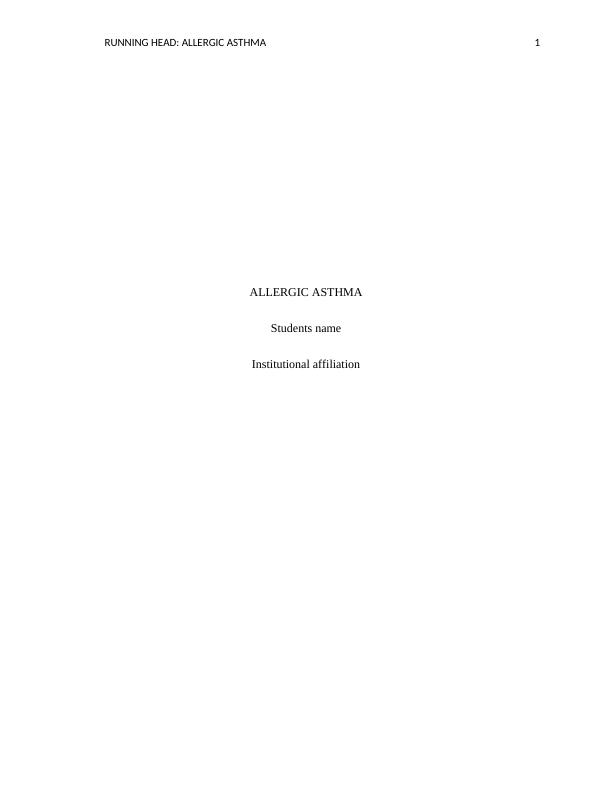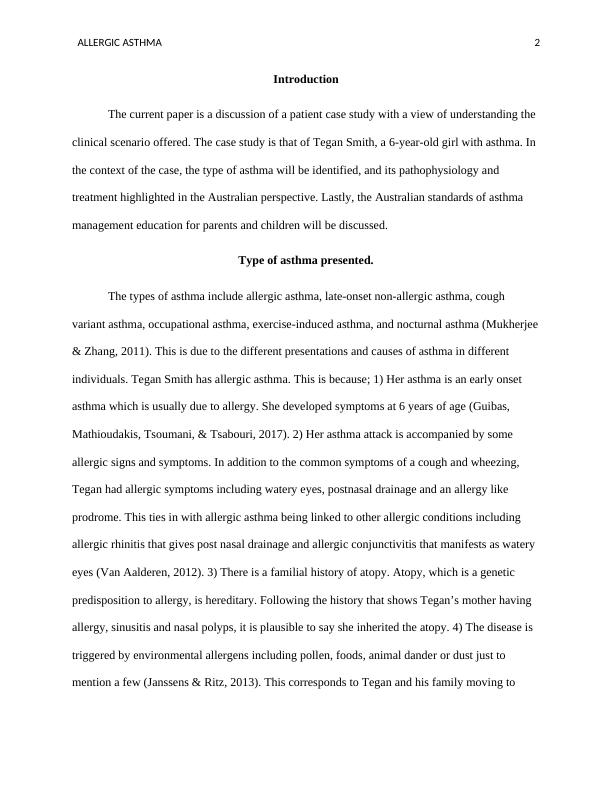Understanding Allergic Asthma: Pathophysiology, Treatment and Education
Added on 2023-06-14
7 Pages1690 Words115 Views
RUNNING HEAD: ALLERGIC ASTHMA 1
ALLERGIC ASTHMA
Students name
Institutional affiliation
ALLERGIC ASTHMA
Students name
Institutional affiliation

ALLERGIC ASTHMA 2
Introduction
The current paper is a discussion of a patient case study with a view of understanding the
clinical scenario offered. The case study is that of Tegan Smith, a 6-year-old girl with asthma. In
the context of the case, the type of asthma will be identified, and its pathophysiology and
treatment highlighted in the Australian perspective. Lastly, the Australian standards of asthma
management education for parents and children will be discussed.
Type of asthma presented.
The types of asthma include allergic asthma, late-onset non-allergic asthma, cough
variant asthma, occupational asthma, exercise-induced asthma, and nocturnal asthma (Mukherjee
& Zhang, 2011). This is due to the different presentations and causes of asthma in different
individuals. Tegan Smith has allergic asthma. This is because; 1) Her asthma is an early onset
asthma which is usually due to allergy. She developed symptoms at 6 years of age (Guibas,
Mathioudakis, Tsoumani, & Tsabouri, 2017). 2) Her asthma attack is accompanied by some
allergic signs and symptoms. In addition to the common symptoms of a cough and wheezing,
Tegan had allergic symptoms including watery eyes, postnasal drainage and an allergy like
prodrome. This ties in with allergic asthma being linked to other allergic conditions including
allergic rhinitis that gives post nasal drainage and allergic conjunctivitis that manifests as watery
eyes (Van Aalderen, 2012). 3) There is a familial history of atopy. Atopy, which is a genetic
predisposition to allergy, is hereditary. Following the history that shows Tegan’s mother having
allergy, sinusitis and nasal polyps, it is plausible to say she inherited the atopy. 4) The disease is
triggered by environmental allergens including pollen, foods, animal dander or dust just to
mention a few (Janssens & Ritz, 2013). This corresponds to Tegan and his family moving to
Introduction
The current paper is a discussion of a patient case study with a view of understanding the
clinical scenario offered. The case study is that of Tegan Smith, a 6-year-old girl with asthma. In
the context of the case, the type of asthma will be identified, and its pathophysiology and
treatment highlighted in the Australian perspective. Lastly, the Australian standards of asthma
management education for parents and children will be discussed.
Type of asthma presented.
The types of asthma include allergic asthma, late-onset non-allergic asthma, cough
variant asthma, occupational asthma, exercise-induced asthma, and nocturnal asthma (Mukherjee
& Zhang, 2011). This is due to the different presentations and causes of asthma in different
individuals. Tegan Smith has allergic asthma. This is because; 1) Her asthma is an early onset
asthma which is usually due to allergy. She developed symptoms at 6 years of age (Guibas,
Mathioudakis, Tsoumani, & Tsabouri, 2017). 2) Her asthma attack is accompanied by some
allergic signs and symptoms. In addition to the common symptoms of a cough and wheezing,
Tegan had allergic symptoms including watery eyes, postnasal drainage and an allergy like
prodrome. This ties in with allergic asthma being linked to other allergic conditions including
allergic rhinitis that gives post nasal drainage and allergic conjunctivitis that manifests as watery
eyes (Van Aalderen, 2012). 3) There is a familial history of atopy. Atopy, which is a genetic
predisposition to allergy, is hereditary. Following the history that shows Tegan’s mother having
allergy, sinusitis and nasal polyps, it is plausible to say she inherited the atopy. 4) The disease is
triggered by environmental allergens including pollen, foods, animal dander or dust just to
mention a few (Janssens & Ritz, 2013). This corresponds to Tegan and his family moving to

ALLERGIC ASTHMA 3
Mount Buller Alpine resort prior to the symptoms starting. This being a highland area is teaming
with environmental allergens including pollen.
Pathophysiology of allergic asthma
Asthma is a chronic condition characterized by airway hyperresponsiveness to allergens,
bronchoconstriction, acute and chronic inflammation and airway remodeling (Kumar, Abbas &
Aster, 2015). There is an interplay between genetics shown by atopy and environmental factors
shown by environmental triggers. The initial event is exposure to the allergen or trigger leading
to Th2 immune response with production of IgE antibodies (Kumar, Abbas & Aster, 2015). On
repeated exposure crosslinking of IgE leads to mast cell degranulation with release of cytokines
(Bonsignore et al, 2015). This is the reason for the hyperresponsiveness to various stimuli. The
release of inflammatory mediators leads to two phases of reactions, an early phase, and a late
phase. During the early phase, there is bronchoconstriction, mucosal hyperstimulation leading to
overproduction of mucus and vasodilation (Kumar, Abbas & Aster, 2015). The early phase
reaction is due to mast cell degranulation with release of mediators including histamine.
Bronchoconstriction is due to direct influence of the mediators on vagal receptors. The late phase
is due to recruitment of neutrophils, eosinophils and more T cells (Bonsignore et al, 2015. There
are repeated episodes of inflammation leading to changes in the bronchial smooth muscle termed
airway remodeling. It involves deposition of collagen, hypertrophy of smooth muscle in the
bronchial walls and increased glands (Kumar, Abbas & Aster, 2015). This process is what
underlies the presentation of asthma with a cough due to increased mucus production, wheezing
due to bronchoconstriction and airflow obstruction (Lødrup & Pijnenburg, 2015).
Mount Buller Alpine resort prior to the symptoms starting. This being a highland area is teaming
with environmental allergens including pollen.
Pathophysiology of allergic asthma
Asthma is a chronic condition characterized by airway hyperresponsiveness to allergens,
bronchoconstriction, acute and chronic inflammation and airway remodeling (Kumar, Abbas &
Aster, 2015). There is an interplay between genetics shown by atopy and environmental factors
shown by environmental triggers. The initial event is exposure to the allergen or trigger leading
to Th2 immune response with production of IgE antibodies (Kumar, Abbas & Aster, 2015). On
repeated exposure crosslinking of IgE leads to mast cell degranulation with release of cytokines
(Bonsignore et al, 2015). This is the reason for the hyperresponsiveness to various stimuli. The
release of inflammatory mediators leads to two phases of reactions, an early phase, and a late
phase. During the early phase, there is bronchoconstriction, mucosal hyperstimulation leading to
overproduction of mucus and vasodilation (Kumar, Abbas & Aster, 2015). The early phase
reaction is due to mast cell degranulation with release of mediators including histamine.
Bronchoconstriction is due to direct influence of the mediators on vagal receptors. The late phase
is due to recruitment of neutrophils, eosinophils and more T cells (Bonsignore et al, 2015. There
are repeated episodes of inflammation leading to changes in the bronchial smooth muscle termed
airway remodeling. It involves deposition of collagen, hypertrophy of smooth muscle in the
bronchial walls and increased glands (Kumar, Abbas & Aster, 2015). This process is what
underlies the presentation of asthma with a cough due to increased mucus production, wheezing
due to bronchoconstriction and airflow obstruction (Lødrup & Pijnenburg, 2015).

End of preview
Want to access all the pages? Upload your documents or become a member.
Related Documents
Asthma: Pathophysiology, Treatment and Educationlg...
|7
|1665
|323
Asthma: Definition, Etiology, Pathogenesis, Signs and Symptoms, Interventions, and Nursing Implicationslg...
|10
|2137
|423
Acute Severe Asthma: Definition, Etiology, Pathogenesis, Signs and Symptomslg...
|9
|2162
|171
Pharmacology Case Study: Asthma, GERD, and Depressionlg...
|10
|2487
|239
The Bronchial asthma managementlg...
|6
|1475
|237
Sample Assignment on Allergiclg...
|5
|1417
|38
